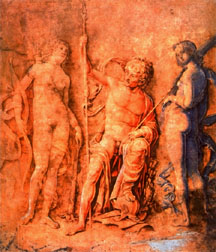Art Archive - Diana
Paintings depicting the goddess Diana.
Alphabetical order by Painter

Francois Boucher,1703-1770.
Diana Leaving the Bath(154K GIF)
Painting (1742). Louvre, Paris, France.
(c) Image courtesy of the Reunion des Musees Nationaux, France.

Francois Boucher, 1703-1770.
Jupiter in the Guise of Diana and the Nymph Callisto(240K GIF)
Painting (1759). Image courtesy of The Nelson-Atkins Museum of Art, Kansas City, Missouri.
(Purchase: Nelson Trust).

School of Fontainebleau.
Diane Chasseresse(74K JPEG)
Painting. Image courtesy of Corel Corporation.

Andrea Mantegna
Mars, Venus, and Diana(102K JPEG)
Image courtesy of Corel Corporation.

Diana of Ephesus(54K JPEG).
Statue of Diana of Ephesus in Villa d'Este. Italy.
Image courtesy of Corel Corporation.

Symposium of the Gods(172K JPEG).
Left section of the east frieze of the Siphnian Treasure (c. 525 B.C.) depicting from left to right Venus, Diana, and Apollo.
Image courtesy of the Ephorate of Prehistoric and Classical Antiquities in Delphi, Greece.
(c) Greek Ministry of Culture - Archaeological Receipt Fund.

Diana the Huntress(54K JPEG).
Statue of Diana the Huntress used as garden ornament in Versailles, France.
Image courtesy of Corel Corporation.
You might also be interested in:

How did life evolve on Earth? The answer to this question can help us understand our past and prepare for our future. Although evolution provides credible and reliable answers, polls show that many people turn away from science, seeking other explanations with which they are more comfortable.
...more
Diana was an ancient Italian goddess of woodland. In Capua and in Aricia, a locality near Rome, there are still shrines dedicated to the old Italian goddess. Her shrine in Aricia was on the shores of
...more
Gaea was the great deity of the early Greeks. She represented the Earth and was worshipped as the universal mother who had created the universe and borne both the first race of gods (the Titans) and the
...more
Following the defeat of the Titans by the Jovian gods, Hades obtained the kingdom of the underworld. One day, while he was riding through the field of battle, the goddess Aphrodite had her companion Eros
...more
In Roman mythology, Jupiter was the king of heaven and Earth and of all the Olympian gods. He was also known as the god of justice. He was named king of the gods in the special meeting that followed his
...more
Neptune was the name that ancient Romans gave to the Greek god of the sea and earthquakes, Poseidon. He was the brother of Jupiter (Zeus) and of Pluto (Hades). After the defeat of their father Saturn (Cronos),
...more
Following the defeat of the Titans by the Jovian gods, Pluto obtained the kingdom of the underworld. One day, while he was riding through the field of battle, the goddess Venus had her companion, Cupid,
...more
Poseidon was the Greek god of the sea and earthquakes. Poseidon was depicted as a bearded man with long hair, holding a trident and accompanied by dolphins and fish. He had the reputation for having a
...more




















